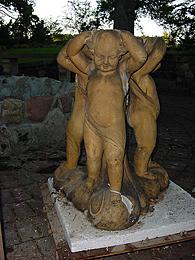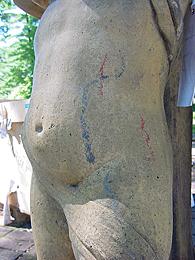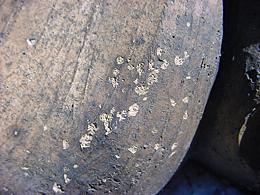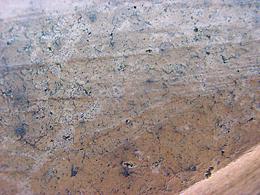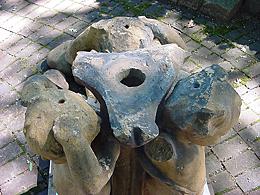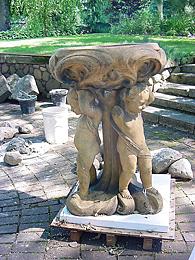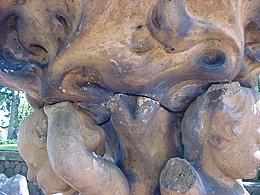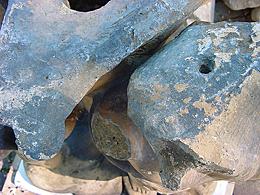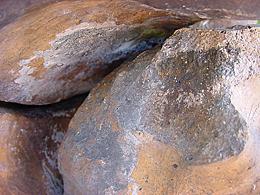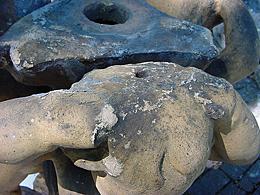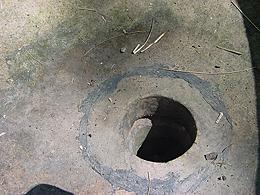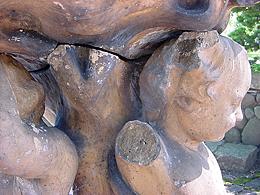|
|
The sculpture is probably a heavily tempered ceramic with an applied slip surface. Acid tests show that the inclusions, body and surface do not have carbonates. There are three holes on the top of the Putti heads, but no corresponding holes in the bottom of the curved bowl. A central hole allows water to flow through the sculpture and out the top into the bowl. CONDITION REPORT:
|
| |
|
Graffiti, Stains and Accretions: Graffiti: The belly of one of the Putti has black and red marks on it. See image 3. Stains: The three holes in the top of the Putti heads have red stains, probably iron corrosion product stains. There are no dowels present in the holes. Image 3 shows holes. There are dark stains over large areas of the surface, as shown by images 1, 7 and 9.
|
| |
|
Accretions: The underside of the bowl has three spots of mortar, which may have been used to level the bowl. There is a gray-white accretion on the interior surfaces of the Putti and underside of the bowl, with some spilling over onto the front of one of the Putti. This accretion does not dissolve in acid, suggesting that it is a mortar or a sulfate accretion rather than a carbonate accretion from the water. Image 5 shows the gray accretions on the back of the Putti head and underside of the bowl. Image 8 shows some of these accretions on top surfaces of the Putti section.
|
|
|
Inside the bowl is a circle of dark material, probably a putty, caulk or other flexible filler to seal the sides of the pipe carrying water up the sculpture interior. See image 11.
|
|
|
Cracks, Abrasion, Breaks and Losses: Proper right arm of one of the Putti is broken at the shoulder and just past the wrist. A triangular piece of the hand is missing. There are tiny fresh chip losses along the shoulder break edge of the arm piece. Otherwise, these breaks are stained dark, suggesting that they are older breaks. Images 4 through 8 show this break area on the main sculpture.
There are fresh chips, abrasion and small breaks on the sculpture, especially along the bottom and top edges. These may have occurred during disassembly. Image 10 shows a small loss in the hand of one of the Putti. Tiny crack networks in the surface of the sculpture seem to be relatively solid. Only a few small areas show lifting. The cracks tend to be stained in a similar manner as the small holes mentioned under dirt and grime. See image 2 (above).
|
|
|
|
|
Small areas of surface spalling are found in patches over the entire sculpture. The worst areas are near submerged or constantly wetted surfaces. Image 9 shows the spalling on the rim of the bowl. The Putti arm in image 10 shows a few spalling spots, too. TREATMENT:
RECOMMENDATIONS: Surface spalling is the result of the sculpture’s use as a fountain. Surface loss will probably continue as the fountain continues to be used. As much as possible, the fountain should be above the pool with supports sloping away from the sculpture. A surface consolidant may retard deterioration, although it probably will lead to further damage over time including discoloration, surface skin formation with subsequent peeling, and unusual cracking. Research on the sculpture suggests that it is a ceramic rather than cement. Silanes may work as a network enhancer, strengthening the ceramic matrix, but their use would be purely experimental. The effectiveness of them as a consolidant cannot be well estimated until they are used in this application. They may cause color alteration of the sculpture. TOTAL TREATMENT TIME: 16 HOURS CONSERVATOR: Helen Alten DATE: September 21, 2000 |

